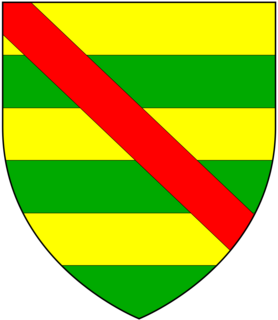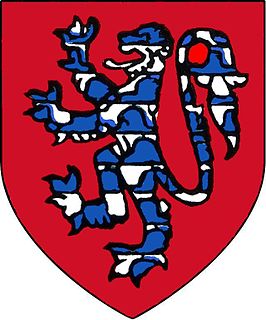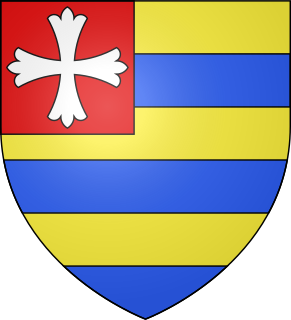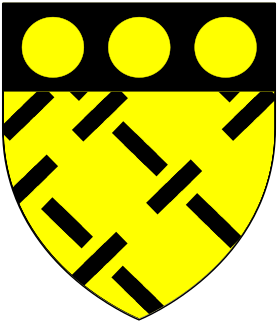
Baron Audley is a title in the Peerage of England first created in 1313, by writ to the Parliament of England, for Sir Nicholas Audley of Heighley Castle, a member of the Anglo-Norman Audley family of Staffordshire.

Marquess of Winchester is a title in the Peerage of England that was created in 1551 for the prominent statesman William Paulet, 1st Earl of Wiltshire. The marquessate is the only English one in existence (extant) therefore its holder is considered the premier marquess of England. The current holder is Nigel Paulet, 18th Marquess of Winchester whose son uses the courtesy title Earl of Wiltshire.

Baron de Ros of Helmsley is the premier baron in the Peerage of England, created in 1288/89 for William de Ros, with precedence to 24 December 1264. Premier baron is a designation and status awarded to the holder of the most ancient extant barony of the Peerage of England. The present premier baron is Baron de Ros. Before the Dissolution of the Monasteries the Prior of the Order of St John in England was deemed premier baron.

Baron Hastings is a title that has been created three times. The first creation was in the Peerage of England in 1290, and is extant. The second creation was in the Peerage of England in 1299, and became extinct on the death of the first holder in c. 1314. The third creation was in the Peerage of England in 1461, and has been in abeyance since 1960.

The barony of Camoys was created twice. From 26 November 1313 to 1 April 1335 Ralph de Camoys (d.1336) was summoned to Parliament by writ, and is thereby held to have become Baron Camoys of the first creation. Ralph de Camoys (d.1336) married firstly, Margaret de Brewes, daughter of William de Brewes, 1st Lord Brewes (d.1291), and secondly, Elizabeth le Despenser, daughter of Hugh le Despenser, 1st Earl of Winchester.

Baron de Clifford is a title in the Peerage of England. It was created in 1299 for Robert de Clifford (c.1274–1314), feudal baron of Clifford in Herefordshire, feudal baron of Skipton in Yorkshire and feudal baron of Appleby in Westmoreland. The title was created by writ, which means that it can descend through both male and female lines. The Norman family which later took the name de Clifford settled in England after the Norman Conquest of 1066 and was first seated in England at Clifford Castle in Herefordshire. The first Baron served as Earl Marshal of England but was killed at the Battle of Bannockburn in 1314. His 8th generation descendant the 11th Baron, was created Earl of Cumberland in 1525, whose grandson the 3rd Earl was a noted naval commander. On the latter's death in 1605 the earldom passed to his younger brother, the 4th Earl.

The title Baron Berkeley originated as a feudal title and was subsequently created twice in the Peerage of England by writ. It was first granted by writ to Thomas de Berkeley, 1st Baron Berkeley (1245–1321), 6th feudal Baron Berkeley, in 1295, but the title of that creation became extinct at the death of his great-great-grandson, the fifth Baron by writ, when no male heirs to the barony by writ remained, although the feudal barony continued. The next creation by writ was in 1421, for the last baron's nephew and heir James Berkeley. His son and successor William was created Viscount Berkeley in 1481, Earl of Nottingham in 1483, and Marquess of Berkeley in 1488. He had no surviving male issue, so the Marquessate and his other non-inherited titles became extinct on his death in 1491, whilst the barony passed de jure to his younger brother Maurice. However William had disinherited Maurice because he considered him to have brought shame on the noble House of Berkeley by marrying beneath his status to Isabel, daughter of Philip Mead of Wraxhall, an Alderman and Mayor of Bristol. Instead he bequeathed the castle, lands and lordships comprising the Barony of Berkeley to King Henry VII and his heirs male, failing which to descend to William's own rightful heirs. Thus on the death of King Edward VI in 1553, Henry VII's unmarried grandson, the Berkeley inheritance returned to the family. Therefore, Maurice and his descendants from 1492 to 1553 were de jure barons only, until the return of the title to the senior heir Henry, becoming de facto 7th Baron in 1553. Upon his death he was succeeded by his relative George Harding.
Baron Darcy de Knayth is a title in the Peerage of England. It was created in 1332 for John Darcy with remainder to his heirs general, allowing daughters to inherit.

Baron St John of Bletso, in the County of Bedford, is a title in the Peerage of England. It was created in 1582 for Oliver St John.
Baron Lisle was a title which was created five times in the Peerage of England during the Middle Ages and Tudor period, and once in the Peerage of Ireland in the 18th century.
The title Baron Bergavenny was created several times in the Peerage of England and once in the Peerage of Great Britain, all but the first being baronies created by error. Abergavenny is a market town in South East Wales with a castle established by the Norman lord Hamelin de Balun c. 1087.

Michael de Poynings, 1st Baron Poynings, Knt., of Bures St. Mary, Suffolk, was an English nobleman and soldier. He was present at the Battle of Crécy.

The titles Baron Montacute or Baron Montagu were created several times in the Peerage of England for members of the House of Montagu. The family name was Latinised to de Monte Acuto, meaning "from the sharp mountain"; the French form is an ancient spelling of mont aigu, with identical meaning.

John Paulet, 2nd Marquess of Winchester, styled The Honourable John Paulet between 1539 and 1550, Lord St John between 1550 and 1551 and Earl of Wiltshire between 1551 and 1555, was an English peer. He was the eldest son of William Paulet, 1st Marquess of Winchester and Elizabeth Capel.

William Paulet, 3rd Marquess of Winchester was an English nobleman, the son of John Paulet, 2nd Marquess of Winchester and his first wife, Elizabeth Willoughby. His maternal grandfather was Robert Willoughby, 2nd Baron Willoughby de Broke.

William Paulet, 4th Marquess of Winchester was an English nobleman, the son of William Paulet, 3rd Marquess of Winchester and Anne or Agnes Howard. He was styled Lord St. John from 1576 to 1598. He was summoned to Parliament on 16 January 1581 in his father's barony as Lord St. John. On 24 November 1598, he succeeded his father as 4th Marquess of Winchester. Paulet experienced great financial difficulties arising from his magnificent style of living and his lavish entertainment of Elizabeth I at Basing House.

Baron FitzWarin is an abeyant title in the Peerage of England. It was created by Writ of summons for Fulk V FitzWarin in 1295. His family had been magnates for nearly a century, at least since his grandfather Fulk III FitzWarin had recovered Whittington Castle in 1205. This castle near Oswestry was their main residence and the seat of a marcher lordship. It was regarded as situated in the county of Shropshire since 1536 and also in the Domesday Book of 1086, but for much of the intervening period was regarded as part of Wales.

Baron Everingham is an abeyant title in the Peerage of England. It was created by Writ of summons to Parliament of Adam de Everingham of Laxton, Nottinghamshire, on 4 March 1309. It passed to his son Adam but fell into abeyance upon the death of his childless grandson Robert in 1371.

Sir William de Aton, 2nd Baron Aton, of Ayton and Malton Yorkshire was a 13th–14th century English noble. He died c. 1388.

Baron St Amand was a title created twice in the Peerage of England: firstly in 1299 for Amauri de St Amand (1269-1310), who died without issue, when it became extinct; and secondly in 1313 for his brother John de St Amand (1283/6-1330).












